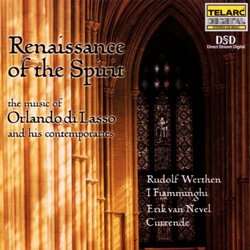| All Artists: Johannes Ciconia, Clemens non Papa, Guillaume Dufay, Antoine de Fevin, Nicolas Gombert, Orlande de Lassus, Philippe de Monte, Philippe Rogier, Etienne du Tertre, Adrian Willaert Title: Renaissance of the Spirit: the music of Orlando di Lasso and his contemporaries Members Wishing: 0 Total Copies: 0 Label: Telarc Release Date: 5/23/2000 Genres: Dance & Electronic, Special Interest, Pop, Classical Styles: Vocal Pop, Opera & Classical Vocal, Chamber Music, Historical Periods, Early Music Number of Discs: 1 SwapaCD Credits: 1 UPC: 089408052125 |
Search - Johannes Ciconia, Clemens non Papa, Guillaume Dufay :: Renaissance of the Spirit: the music of Orlando di Lasso and his contemporaries
 | Johannes Ciconia, Clemens non Papa, Guillaume Dufay Renaissance of the Spirit: the music of Orlando di Lasso and his contemporaries Genres: Dance & Electronic, Special Interest, Pop, Classical
|
Larger Image |
CD Details |
CD ReviewsStylish and perfectly historically aware performances in gor Sator | Sydney, Australia | 07/13/2005 (5 out of 5 stars) "Erik van Nevel is a performing musician who also teaches choral conducting, chamber music and early music performance practice at the Lemmens Institute in Leuven. He conducts workshops and courses and master classes for choral and ensemble singers, as well as conductors, focusing both on general choral and conducting technique and on more specific performance practices. There was a period when performances of Renaissance works performed on instruments or with instrumental doubling of vocal parts came to be frowed upon in preference to a capella performances. Around the time this recording was released things had come full circle and both approaches came to be embraced. Erik van Nevel is clearly a scholar fully aware of the latest thoughts in these matters and the listener can rest assured that in matters of performance practice he knows perfectly well what he is doing. The suggestions of ignorance from the previous reviewer should be turned instead on the reviewer himself. Recordings by Erik van Nevel tend to be terribly difficult to get a hold of, even though he is as good as or better than many of other better known performers in the field of Renaissance polyphony. So this recording should be heartily welcomed by all lovers of Renaissance music. The selection of music here is all wonderfully chosen to illustrate the musical tendencies amongst Lassus' contemporaries, although the much earlier composers Févan, Dufay and Ciconia also make something of a surprise appearance too. So even the slightly hodge podge anthological nature of the CD fails to detract from the fact that most of these works are otherwise unobtainable and above all immensely rewarding to listen to. Particularly noteworthy are the 'Respice in me' by Rogier, the Gombert 'Ave maria' and the de Monte 'Bona est oratio cum ieiunio' just to name a couple of works. Given that van Nevel's performances can be quite revelatory, he really does deserve to be recorded much more often than he is. And when he has been recorded it has always been in boxy limited sound, so the spectacular audiophile recording he receives here is an embarrassment of riches. A DSD processing system was used along with the usual expertise of the Telarc recording team. The sound-staging is stunning, with wonderful detail, and the typical DSD refinements in sound. It is like taking the cotton wool out of your ears. This may be the most sumptuously recorded Renaissance music CD available today. Ivan Moody on Goldberg early music magazine had this to say: "This is a brilliantly accomplished recording in which a smaller group of players from I Fiamminghi shows a real grasp of the idiom of this repertoire. Currende sing with passion and conviction, and are not afraid to allow the darker, meditative aspect of much of this music come out (try Clemens's Ave Maria, for example, or de Monte's Bona est oratio cum ieiunio, for example, where the long-breathed lines of this penitential work are really shaped so that the ensuing harmonic flow seems effortless). I Fiamminghi impress by their slick rhythmic phrasing, their unanimity and their smoothness of sound: the sensation on hearing the very first chord of the first track (an instrumental rendition of Lassus' Passan vostri triomphi) is that one has walked into a velvet cathedral of sound." Telarc - please can we have more!" A question of "arrangements" but very good otherwise F. Behrens | Keene, NH USA | 06/20/2000 (4 out of 5 stars) "Spanning the years 1430-1600, the Telarc (CD 80521) offers up to 21 examples of Spanish music that provide 67 minutes of absolutely gorgeous orchestral and vocal renditions of pieces known mostly to specialists and scholars. In fact, the featured group, I Fiamminghi, is named after the Italian name for musicians from Flanders who enhanced the Renaissance with their compositions. For "a more authentic performance," four recorders and a lute were added to the usual complement of players. For the vocal selections, they are joined by the Capella Corrende under Erik Van Nevel. Although the liner notes are silent on this point, the press release quotes conductor Rudolf Werthen thus: "It is interesting when music of the 'past' is performed in a 'contemporary' way.... The alternation of our arrangement with works in their original form...provides the audience with a deeper perception of the compositions that form much European music." I leave it to my betters to determine how "contemporary" treatment of Renaissance music "works" in this context; but it might give a pause to any teacher wishing to use this CD as an educational tool. For myself, I find it very pleasant if somewhat over-consistently serious."
|

 Track Listings (21) - Disc #1
Track Listings (21) - Disc #1